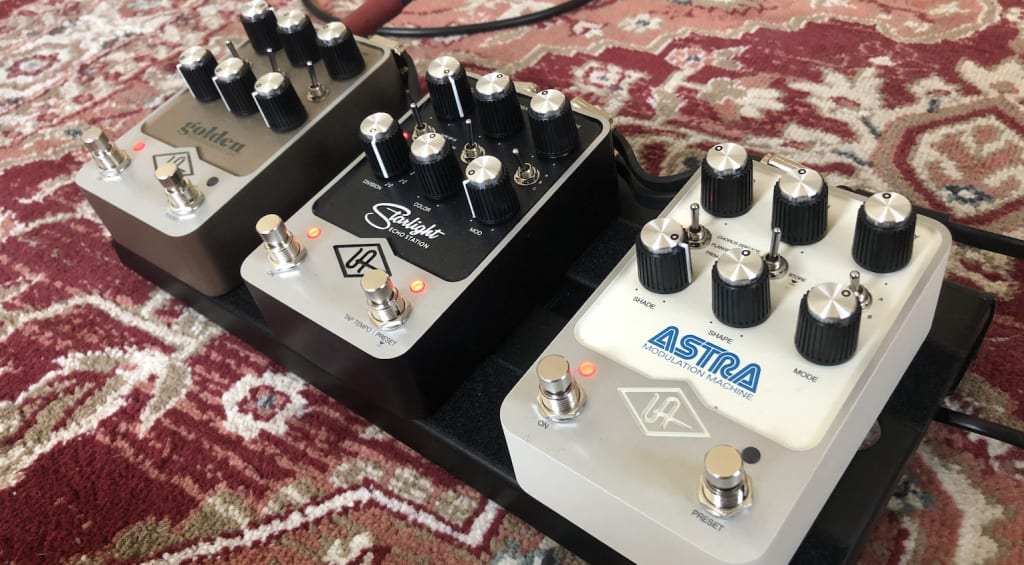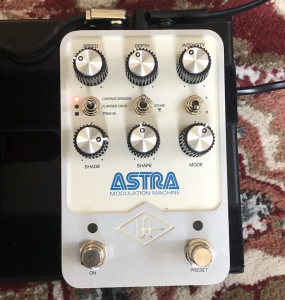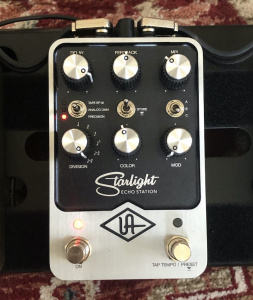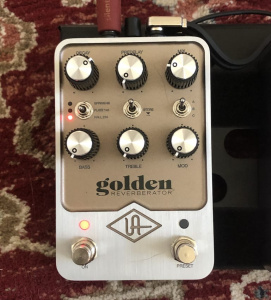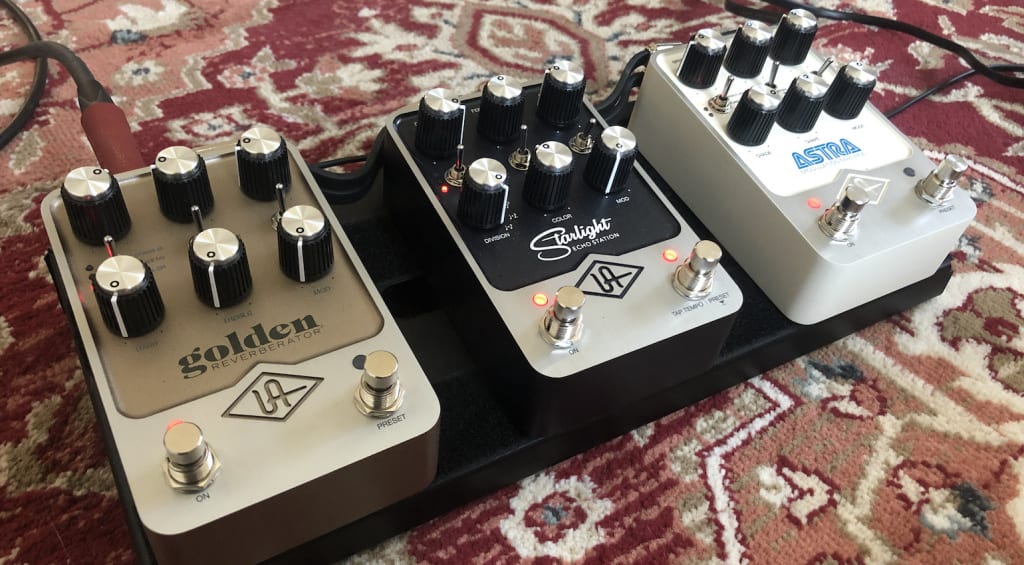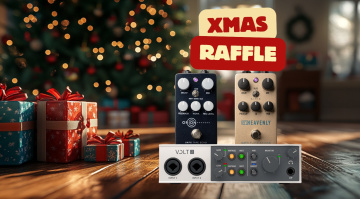Review: UAFX Golden Reverberator, Starlight Echo Station and Astra Modulation Machine
Three new guitar pedals from Universal Audio
Earlier this year, Universal Audio announced a trio of guitar pedals to much fanfare, the Golden Reverberator, Starlight Echo Station and the Astra Modulation Machine. I was lucky enough to receive one of each, but had just one day for this review. How good are the tones on offer here? How intuitive are these pedals to use? What kind of sounds could I coax from them without studying the manual for hours? Time to get hands-on with some Universal Audio guitar boxes!
UAD UAFX Guitar Pedals
Universal Audio is probably best known for its interfaces and plugins. So we were all excited to hear the company launch its new trio of UAFX pedals back in January. All three pedals come in a solid housing and I wouldn’t be too worried if they got knocked about. So gigworthy, for sure. Another thing that appealed to me about the pedals were their dual-processors. This meant I could save a preset and switch over to it while running the pedal on a different setting and it should, in theory, be seamless. Each pedal had a set of 6 knobs that control different parameters, 3 mini-switches, and two footswitches.
In this review, I decided to use them in mono. The signal chain was my guitar to my pedalboard, then out through the UAFX Astra Modulation Machine, UAFX Starlight Echo Station and UAFX Golden Reverberator, and into a clean amp. Because I was approaching this in a very hands-on way, I spent very little time working through the manuals. Plugged straight in, and hoped for the best. With each pedal, I started with all knobs at the 12 o’clock position.
UAFX Astra Modulation Machine
The Astra Modulation Machine offers three different types of modulation: Chorus Brigade, Flanger DBLR, and Trem 65. The top row has controls for Speed, Depth and Intensity, and the bottom for Shade, Shape and Mode. There are three mini-switches, one to choose the type of effect, one to Store the preset, and an A/B variation switch.
Black Hole Sun
I have been digging into Chris Cornell’s sounds on Soundgarden’s Superunkown album recently, so I decided to start with the Trem 65 function to cop the Leslie Fender Vibratone on Black Hole Sun. The record features two speeds. Fast on the verses, and Slow on the choruses. I messed around with the Speed, Depth and Intensity controls until I felt I had a close simulation of the Slow setting on the song. Then I flicked the ‘Store’ switch down. After this, I increased the Speed to the verse bit and tried going between the two settings (the right footswitch is for the Preset). Nothing. I set the Speed again, and this time held the Store switch down a bit longer. A green light blinked over the Preset footswitch, confirming that the Preset had been saved. Success! And then I blasted through Black Hole Sun…
Seamless transition
The switching was seamless and, with a little bit of fiddling, the sound was close enough for me. It took all of 5 minutes to get what I wanted, and I was pretty pleased with the quality of the tone. Going through the Chorus Brigade and Flanger DBLR modes was just as intuitive. I confess, I didn’t bother with the Mod knob or the A/B switch as, given the time-frame, I tried to keep it simple.
You are currently viewing a placeholder content from YouTube. To access the actual content, click the button below. Please note that doing so will share data with third-party providers.
I’d been looking into the NEO Instruments micro Vent 16, which is supposed to give an accurate representation of the Fender Vibratone cab used on the track. And it isn’t a cheap pedal either. But for a little extra coin, the UA Astra offers more features and, as I understand it, can be hooked up to a computer for even more options.
UAFX Starlight Echo Station
The UAFX Starlight Echo Station is a delay pedal that gives you three different kinds of delays: Tape EP III, Analog DMM, and Precision. You get controls for Delay, Feedback and Mix, all self-explanatory. Then you get a rotary switch for Division, a Color knob, and a Mod knob. The latter affects the modulation of the selected delay type. There’re three switches, one for selecting the delay mode, one to Store the preset, and an A/B/C switch that selects variations within the selected delay type. Then there’s the two footswitches, one to turn the effect On/Off, and one to load the Preset, which also doubles as a Tap Tempo.
Once again, interested in how it would work intuitively, I just fiddled around with the settings, mostly on the top row of knobs. I didn’t use the note divisions or Delay, instead utilising the Tap Tempo function to time my delays. You can use the Tap Tempo on the fly, and pretty much dial in any length of delay (within reason) you choose.
You are currently viewing a placeholder content from YouTube. To access the actual content, click the button below. Please note that doing so will share data with third-party providers.
Delay – Analog and Digital
I started with the UAFX Starlight Echo Station Tape EP-III mode, which is supposed to emulate a classic tape-based delay. Often with digital emulators, at least the ones I’ve had the chance to try out, the ‘digitalness’ is apparent. The repeated signal is distinct and clear, and doesn’t seem to have that tape or analog feel of washing over each other as they decay, getting warmer and mushier with every repeat. The Starlight doesn’t seem to suffer from that. It’s the same with the Analog DMM mode. But should you need that pristine repeat that only digital delays can offer, just switch the pedal into Precision mode.
While you can use the Tap Tempo footswitch to set the delay speed mid-gig, you can also save a preset. As with the Astra, I found the pedal easy enough to use, without diving into the user manual. I’m sure the pedal has much, much more to offer. But for my applications, it was perfect.
Golden Reverberator
The Golden Reverberator is much simpler to use than, say, the Strymon Nightsky that we got our hands on a few months ago. There are three different reverb modes on offer here, Spring 65, Plate 140, and Hall 224. The top row of knobs has controls for Decay, Predelay and Mix, while the bottom has Bass, Treble and Mod controls. You also get 3 mini-toggle switches, one for selecting the reverb type, one to Store the preset, and an A/B/C switch that selects variations within the active effect.
UAFX Golden Reverberator: Complex yet uncomplicated
The Spring 65 mode conjures up the spring reverbs found on 60’s Fender-style amps. As with the previous two pedals, I started with all the knobs on the noon position. The Decay knob offers three distinct decay times, and will have a split second of audio-loss between changes. The Mix knob then allows you to blend in the reverb with your dry signal. The Mod knob will add a flutter to the reverb. The reverb itself was lush and messing around with the settings offered up several very useful tones. Same with the Plate 140 mode, which is based on plate reverbs found in studios back in the 50s and 60s.
You are currently viewing a placeholder content from YouTube. To access the actual content, click the button below. Please note that doing so will share data with third-party providers.
The Hall 224 is based on digital studio reverbs from the 70s and 80s. Again, some very nice sounds can be dialled in. However, it differs from the other two reverb settings in that the Bass and Treble knobs adjust the decay on the low and high frequencies respectively, while the Decay knob controls the Mids. And when the controls are maxed out, the thing will start self-oscillating like a Banshee. This is when I had to turn to the manual, because I didn’t know how to switch it off, short of pulling out the plug. To stop it abruptly, just flick the A/B/C switch.
Verdict
This new trio of pedals from Universal Audio definitely hit the mark for me. I found all the pedals easy to use and very intuitive. I’m already eyeing the Astra and the Starlight for myself! I’m not really looking for a reverb pedal at the moment, but if I was, the Golden Reverberator would certainly be on my radar. And I haven’t even scratched the surface. Also, when put up against with other comparably priced units, these three new pedals have a lot on offer. And then some.

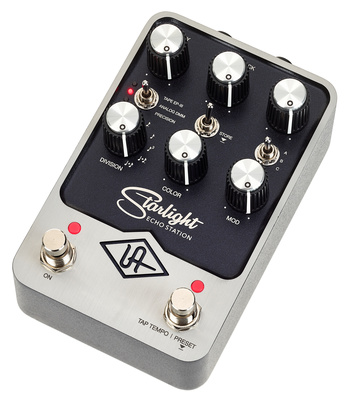

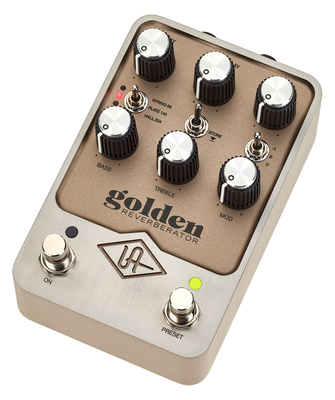

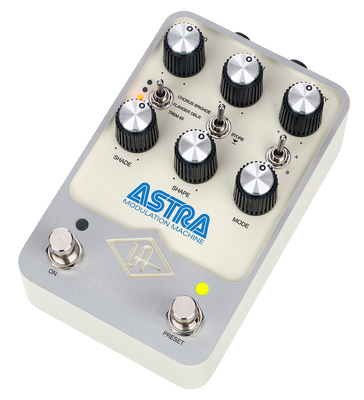
More Information
This post contains affiliate links and/or widgets. When you buy a product via our affiliate partner, we receive a small commission that helps support what we do. Don’t worry, you pay the same price. Thanks for your support!
You are currently viewing a placeholder content from YouTube. To access the actual content, click the button below. Please note that doing so will share data with third-party providers.

 5,0 / 5,0 |
5,0 / 5,0 | 

